Are you looking for the simplest method to add attachments to your WooCommerce order email invoices? If you are, we have the perfect solution for you!
So you have already started your WooCommerce store to sell physical or digital products.
With the help of YayMail, you can customize the WooCommerce email templates to stand out from other regular stores.
Beyond order details and confirmations, there are times when you may want to include an email attachment such as a PDF invoice, warranty guide, product manual, or additional terms.
By default, WooCommerce does not provide an easy way to attach files to your order emails, which limits flexibility. Thankfully, you can now add attachments to your WooCommerce emails with simple tools right from your WordPress dashboard.
In this guide, we will show you how to customize WooCommerce emails and seamlessly include files, such as invoices and PDFs, in your completed order emails or any other notification template.
We’ll explore some of the advantages of including attachments in your WooCommerce emails.
Table of contents
Why Add Attachments to WooCommerce Order Email Invoice
Adding attachments to your WooCommerce order emails makes your communication more professional, convenient, and customer-focused. Here are some key benefits:
- You can include a PDF invoice or receipt so customers always have a formal record of their order email.
- Attachments let you share product manuals, warranty guides, or instructions directly in the completed order emails.
- Sending a custom PDF builds trust by making your WooCommerce email look professional and complete.
- Adding documents to a confirmation email reduces follow-up queries and improves customer satisfaction.
- You can use email attachments for promotional content such as coupons or related products recommendations.
- Including attachments ensures customers have quick access to important order details without visiting the website again.
- A well-structured email attachment helps you comply with legal or accounting requirements like invoices and tax documents.
- Extra files in your WooCommerce order email enhance brand value by offering personalized and helpful resources.
Next, let’s examine the types of attachments that would be suitable for the invoice email.
What Type of Attachments Can You Include in the WooCommerce Emails
- PDF invoice or receipt
- User manuals and product guides
- Warranty documents
- Terms and conditions files
- Custom PDF promotions, such as discount coupons
- Order details in a formatted file
- Shipping labels or return instructions
- Catalogs or brochures for related products
- Certificates or licenses
- Personalized thank you notes or branded messages
In the next section, we will show you how you can add this feature to your WooCommerce store with minimal effort.
How to Add Attachments to WooCommerce Order Email Invoices
We will be using the premium version of YayMail for this task. The latest version of YayMail Premium includes the email attachment feature, making your work easier. Currently, the lite version plugin doesn’t offer this feature.
The first step is to install and activate the YayMail premium plugin on your website. If you do not have the plugin, feel free to get a subscription from here.
After activation, you can see the plugin’s settings on the left-hand side.
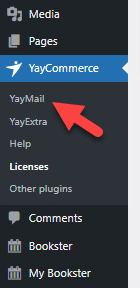
You will be redirected to the plugin’s dashboard.
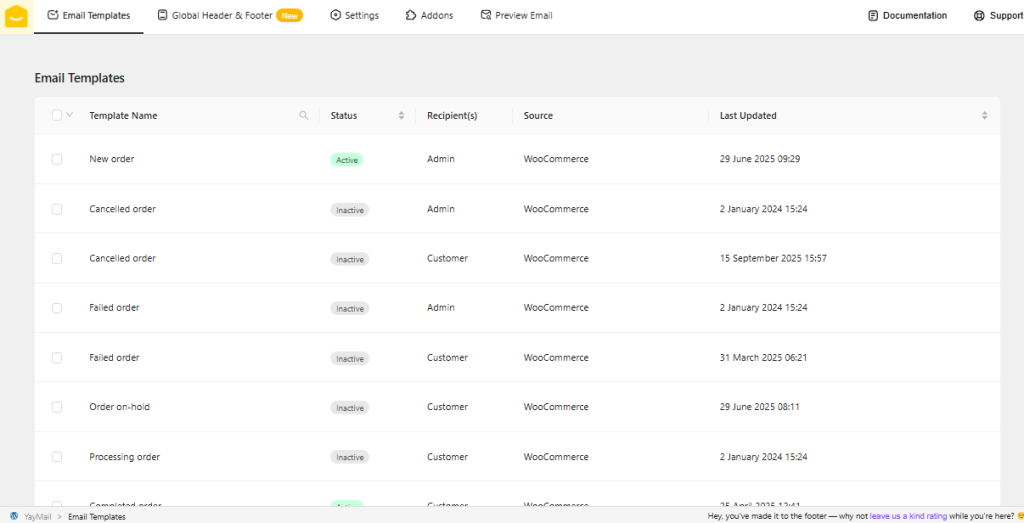
On the top bar, you will see options like:
- Email templates
- Global header and footer
- Settings
- Addon
- Preview email
You need to choose settings from there.

Next, you can see the attachment settings there.
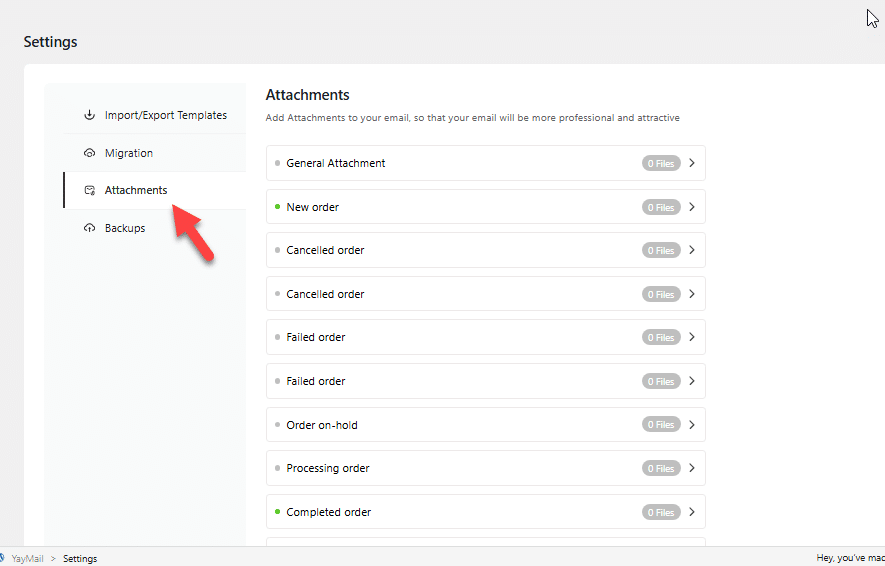
You can see all the templates there, such as:
- General Attachment
- New Order
- Cancelled order (for admin)
- Cancelled order (for customer)
- Failed Order (for admin)
- Failed Order (for customer)
- Order-on-hold
- Processing Order
- Completed Order
And so on.
When you need to add an attachment to any template, expand it and upload the file.
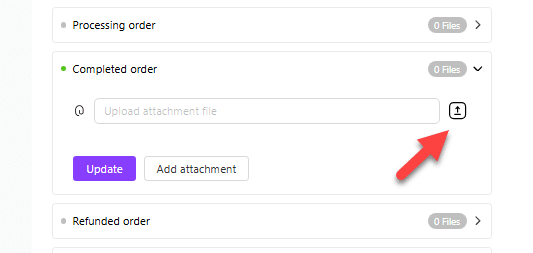
You can choose the attachment from the media library.
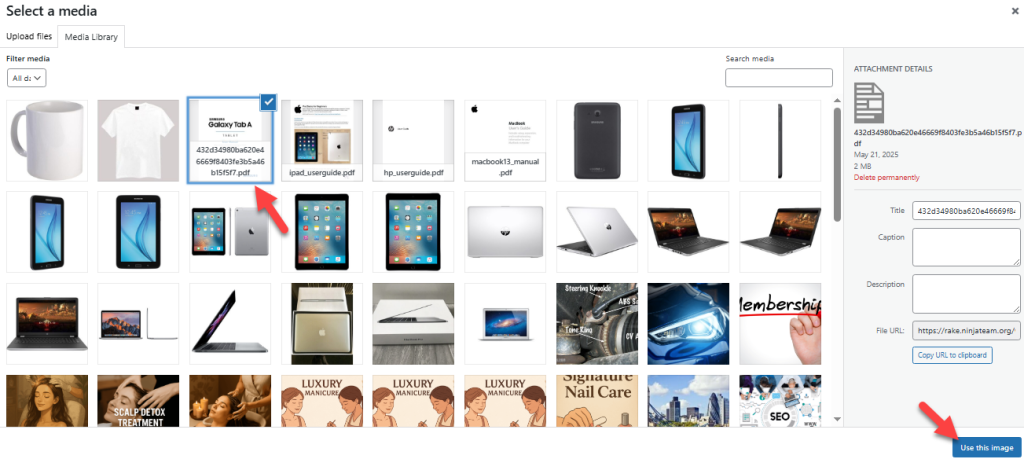
Now update the email template.
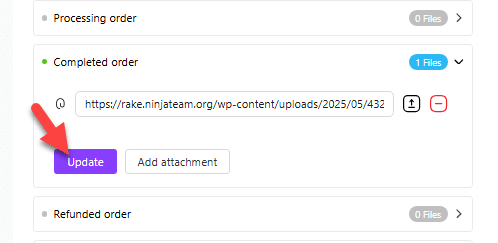
You can add multiple attachments to email templates this way. However, be sure not to add too many, just the most important ones.
You can do the same for all the email templates available. From now on, when a customer or admin receives an email from the store, the attachment will be included with it.
That’s it!
This is how you can add attachments to WooCommerce order email invoices or any other templates.
Best Practices to Follow While Adding Email Attachments to Order Templates
When you add attachments to your WooCommerce order email or invoice template, following best practices ensures smooth delivery and professional communication.
- Always go to YayMail settings and select the email you want to edit before attaching files to keep things organized.
- Use the media library or upload folder for managing PDF files, so your email attachment remains easy to access and update.
- Limit the number of attachments in each order confirmation email to avoid delivery issues and ensure customers receive the order without delays.
- Include only relevant documents like a WooCommerce invoice, order information, or a PDF invoice template for clarity.
- Test your email notification with different order statuses, such as new order or completed order, to confirm attachments are correctly sent.
- Use customization options in the template section to add a notification headline or custom text for better presentation.
- Ensure compatibility by checking if the plugin is tested with other plugins or the WooCommerce core plugin, which is active on your website.
- Keep attachments lightweight so WooCommerce can send every email automatically without hitting server limits.
Frequently Asking Questions
Now, we will see some of the frequently asked questions and answers regarding this topic.
No, WooCommerce does not allow you to add attachments out of the box. With YayMail, you can easily attach files or add custom PDF invoices directly to your customer’s order emails.
YayMail lets you go to WooCommerce email settings in the plugin’s dashboard and attach the PDF or other files. You can select the email you want to edit and add attachments to your WooCommerce emails.
Yes, with YayMail, you can attach files to additional emails, such as new order, completed order, or related products updates. The plugin recognizes and supports all emails added by WooCommerce plugins.
Yes, you can add custom order meta, order ID, or specific order details into your attachments. This ensures every email sent to your customers contains accurate and personalized order information.
Yes, you can add custom order meta, order ID, or specific order details into your attachments. This ensures every email sent to your customers contains accurate and personalized order information.
Yes, the feature is tested with WooCommerce 7 and has made no compatibility issues. You can rely on it to work with your updated WooCommerce store.
Yes, you can use services like YaySMTP or WP Mail SMTP to improve deliverability when you send emails with attachments through YayMail. This ensures files are reliably sent and received by your customers.
Conclusion
Adding attachments to WooCommerce order emails is one of those small but impactful improvements that can significantly enhance your customer experience.
While the default WooCommerce setup does not support email attachment features, YayMail makes it effortless to attach files such as PDF invoices, terms, guides, or additional product information directly to the email template.
With simple customization options inside your WordPress dashboard, you can select the email you want to edit, attach the PDF, and even configure cc or bcc recipients. YayMail recognizes and supports all emails added by WooCommerce plugins, ensuring smooth integration with your store.
Whether you want to customize WooCommerce emails for new orders, completed orders, or other notifications, this feature gives you more control and professionalism.
By using YayMail, you not only streamline communication but also optimize your WooCommerce store for better customer trust and satisfaction.
Would you be adding this feature to your online store?
Let us know in the comments.